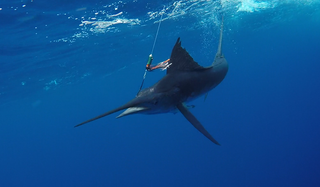If your marlin setup is not dialed in to perfection, the fish will teach you why- fast. The difference between bragging rights and a broken line usually comes down to the details you didn’t double-check.
Every marlin fight tests your gear, your reflexes, and your patience. These fish are just unpredictable. That’s why your setup needs to be more than good; it needs to be tuned for control, endurance, and precision. From your marlin trolling lures to your leader material, every choice determines whether you’re landing a trophy or re-rigging in frustration.
Start with the Foundation: Rods and Reels That Work Under Pressure
Your setup begins where the fight begins: with the rod and reel. When targeting marlin, the goal is control and consistency.
-
Rods: Look for heavy-action trolling rods with a solid backbone but enough flex to absorb shock. Graphite composites are preferred for their strength-to-weight balance.
-
Reels: Pair that with a two-speed lever drag reel that gives you low-end torque for heavy runs and high-speed pickup when you’re trying to gain line quickly. A 50W or 80W class reel is the sweet spot for most offshore setups.
-
Line: Stick with 80–130 lb. Test monofilament or braided mainline with a clear top shot. You want strength without losing stretch.
A perfectly balanced rod and reel combo gives you the power to fight hard and the sensitivity to react fast- something every marlin angler learns the hard way.
The Spread: Presentation That Gets the Strike
Marlin are not shy, but they are selective. A clean, balanced spread makes all the difference when trolling. Most professionals run Marlin Lures in staggered positions, covering different depths and distances to mimic a small, scattered bait school.
Here is a reliable four-lure spread:
-
Short corner: A large resin-head lure with a deep cup face for maximum smoke trail and splash.
-
Long corner: A medium plunger or bullet-style lure to imitate fleeing bait.
-
Short rigger: A skirted lure with contrast color, running in medium wake.
-
Long rigger: A smaller, tighter-running lure to tempt fish that hang further back.
Adjust placement based on wake pattern and sea conditions- rougher days may call for heavier heads or shorter leads to maintain stability.
Fine-Tuning Action with Drag and Speed
Drag pressure can make or break your day. A general rule: set your drag to about one-third of your line’s breaking strength.
Keep your trolling speed between 7 and 9 knots- enough to give your lures life without making them spin. Always test each lure’s swimming action before you settle into the run. The goal is natural movement, not chaos.
Lure Choice
The best anglers treat lure choice like reading the ocean. Marlin behavior shifts with light, current, and water clarity. That’s where premium lures give you the edge- consistency and quality action, no matter what the ocean throws at you.
-
Bright days, clear water: Go with darker lure skirts- blues, purples, and blacks to create contrast.
-
Overcast or low light: Choose lighter or more reflective colors for visibility.
-
Choppy seas: Run heavier-head designs that stay in the water longer.
-
Calm conditions: Try lighter, high-action heads with longer skirts.
And don’t overlook Tuna Poppers- when surface-feeding activity picks up, switching tactics to casting can trigger aggressive bites from nearby pelagics, including small marlin or tuna running with bait schools.
Hook Rigs
Hook configuration can influence the hookup ratio more than you think. Many seasoned marlin anglers prefer single stiff rigs for better penetration and tracking, especially at higher speeds. Double hook rigs still have their place, but can cause more leverage during a jump.
Use stainless or galvanized hooks, always sharpened, and check alignment regularly. A small misalignment can throw off your lure’s swimming action.
Boat Positioning and Reaction Time
Even with the perfect setup, your fight comes down to how quickly you react when that reel screams. Keep communication tight between the angler, helmsman, and crew. A quick turn toward the fish and smooth throttle control can save you hundreds of yards of line- and maybe the fish itself.
It’s also smart to maintain lure spread awareness. Many anglers lose fish because other lines tangle during the chaos. Practice clean, fast clearing drills before the bite happens.
Maintenance- Respect the Gear That Gets It Done
Salt, sun, and time will wear your gear faster than any marlin. After every trip, rinse reels and rods in fresh water, check roller guides for salt buildup, and re-lube drag systems regularly.
Store your trolling lures in dry tackle rolls to prevent skirt damage and corrosion. A bit of maintenance after every trip saves hours of frustration offshore.
Final Thought
The anglers who land big fish consistently are the ones who treat their setup like a system. From your reel drag to your lure selection, every part of your setup should have purpose and reason.
And when you’re ready to upgrade your gear, we at MagBayLures offer precision-engineered lures and poppers built for serious offshore performance. Every lure is tested, balanced, and made to keep you connected when it matters most.
Contact Us today to gear up for your next big run- because your setup should not wait.

